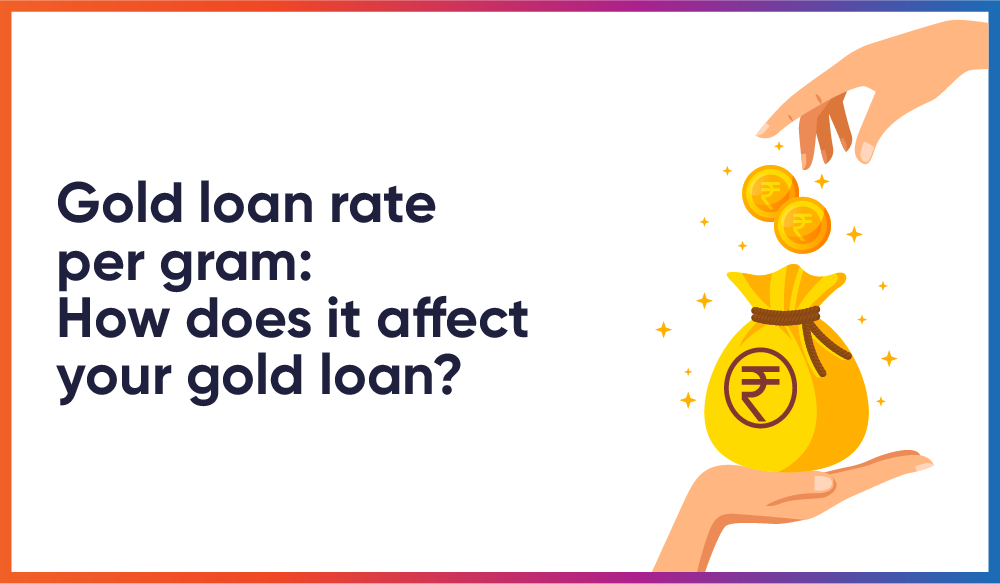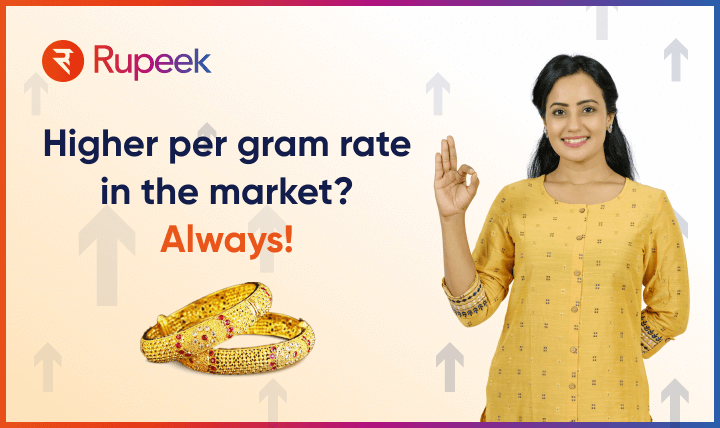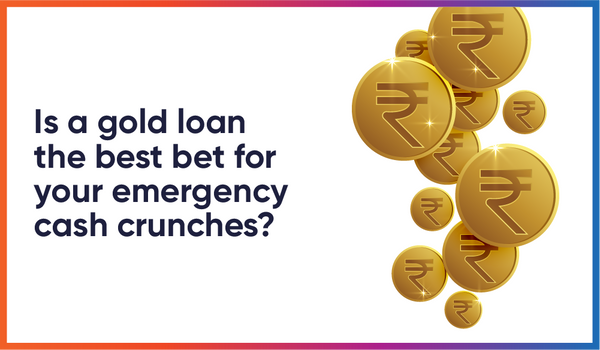According to RBI, public sector banks' total gold loan portfolio has surged 59.1% to Rs. 63,770 crore as of September 2021, which was Rs. 40,086 during the same period last year. Thus, it appears that there has been a shift in the trend as Indians are inclining towards gold loans for their funding purposes.
Now, if you are planning to resort to a gold loan for any monetary requirement, it is ideal to learn about the per gram rate and other facets of this credit instrument to make an informed decision.
What is Per Gram Rate for Gold Loan?
Per gram rate of gold represents the value you can get for 1 gram of gold that you pledge. This rate, however, can be a culmination of a few factors like the weight and purity of a gold item. Along with that, a financier also factors in the average price of gold of certain quality over 30 days before deciding the per gram rate.
Let's look at an example illustrating this point further:
Calculating the loan amount using the per gram rate is very simple. For instance, you have 10 grams of 22-carat gold ornaments, and the per gram rate is Rs. 4000. In that case, the total market value of these gold items is Rs. 40,000. You can get a loan of up to Rs. 30,000 (75% of total market value) against it.
Therefore, you can refer to current gold loan rates to easily find out the loan amount manually. Alternatively, you can use an online calculator for this purpose.
Alongside purity, weight, and average price, the per gram rate of gold also depends on a few other factors. The gold prices across different states and cities of India may fluctuate due to demand, taxes, and transportation costs. For instance, the per gram rate of 22-carat gold on 5th January 2022 in Maharashtra was Rs. 4973 per gram, whereas, in Punjab, this price was Rs. 4921 per gram.
Therefore, if one opts for a gold loan in Punjab, he/she is likely to get a lower loan amount compared to that of Maharashtra.
Another point to keep in mind while studying the per gram rate is that this rate alters every day, and a group of selected traders in every region is responsible for determining it. They will consider the international prices and determine the exact cost of buying or selling gold within India and its different regions.
Now that you understand the gold loan per gram rate, you should learn about the factors that play an active role in determining the gold price in India.
What are the Factors Affecting Gold Price in India?
The factors impacting gold price in India are as follows:
· Inflation
· Demand and supply
· Jewelry market of a country
· Government gold reserves
· Interest rates
· Global trends
· Import duty
· Equation of Rupee and Dollar
Read on to know about these factors in detail.
· Inflation
One of the notable features of gold is that it retains its value irrespective of the economic scenario. This is the reason why gold is considered an inflation hedge.
Since inflation lowers the value of a currency and all other investment options, gold can be a great alternative here. Resultantly, the demand for gold in such a scenario will 'skyrocket' and vice versa.
This theory is applicable not only in India but throughout the world.
· Demand and supply
Similar to any other commodity on sale in the open market, the value of gold also depends on its demand and supply. Unlike consumable products, all the gold mined to date is still available in the market. Moreover, the amount of gold mined every year across the globe is not very high.
Therefore, in case the demand for this yellow metal increases, its supply does not increase parallelly. So, if you are wondering what may cause a sudden price hike of gold, this can be a factor.
· Jewelry market of a country
Keeping in sync with the previous point, the jewelry market of a country also controls the demand supply in that region and decides the gold prices accordingly. Now, if you take India as an example here, purchasing gold items is a common household affair. Be it weddings, birthdays, or any other festival, Indians spend heavily to invest in gold items. Hence, its price usually shoots up during festive seasons.
Apart from that, gold has industrial applications as well. It includes manufacturing parts for electronic devices or medicines.
· Government gold reserves
Every country, be it India or another, has a gold reserve, which has a direct impact on gold prices within the country. In India, the RBI holds this reserve on behalf of the Government of India, and it can sell or buy gold as per requirement.
If RBI procures more gold from the market, it will increase the gold price for you and vice versa. The reason is, it will increase the cash flow in India's economy by lowering the supply of gold.
· Interest rates
Another facet of gold pricing where RBI plays a major role is, controlling interest rates. Current market rates of various financial products can be a fair indicator of trends in gold pricing.
In case the interest rates on various investment products increase, it will lead individuals to sell their gold items and invest for higher returns leading to a drop in demand and price of this yellow metal. However, if this interest rate decreases, an alternative situation will arise, leading to high demand and price of gold.
In a nutshell, gold price and interest rates share an inversely proportional relationship.
· Global trends
Since India is one of the leading importers of gold, any changes on the global stage can directly impact gold prices in India. Moreover, since gold is recognized as a crisis commodity, individuals always invest in it during market fluctuations or political unrest.
· Import duty
As mentioned above, India is one of the largest importers of gold in the world; the import duty can play a part in its rising prices. If this fee rises, it will automatically raise the price of this yellow metal.
· Equation of Rupee and Dollar
Since gold is primarily traded in USD in the international market, if the value of the Rupee lowers against the Dollar, it will appreciate the price of gold articles in India. However, a point to understand here is that this equation has no impact on international gold prices.
Read on to know how gold rates can have a say on your loan application.
How does Gold Rate Impact a Gold Loan Application?
According to RBI's guidelines, any financial institution in India can offer a credit of up to 75% of a gold item's total market value.
This is the LTV or loan-to-value ratio set by India's apex bank for the gold loan industry. It means no financier can offer you a loan against gold that surpasses this threshold. Now to simplify the concept of LTV ratio further, it is a financial term used by loan providers to express the loan amount against the market value of the collateral. In this case, collateral is the gold ornaments that you pledge.
However, the upper limit of a loan can vary depending on the gold ornaments you pledge and a lender's policy.
Let's look at an example for clarification.
You have gold jewelry amounting to Rs. 10 lakh; in that case, you are eligible to have a credit of up to Rs. 7.5 lakh against it. However, if a lender only offers a gold loan of up to Rs. 5 lakh, in that case, you will qualify to get only Rs. 5 lakh and not more than that.
Since the LTV ratio has a vital role in determining a loan amount, you must learn the gold prices beforehand to gauge the loan amount you will qualify for.
Here is a table that illustrates this pointer further:
|
Description |
Case 1 |
Case 2 |
|
Total gold items |
40 grams |
35 grams |
|
Per gram rate (assuming
they are 22-carat gold) |
Rs. 4500 |
Rs. 4500 |
|
Total market value |
Rs. 1,80,000 |
Rs. 1,57,500 |
|
Total loan amount |
Rs. 1,35,000 |
Rs. 1,18,125 |
|
Interest rate |
6% |
6.5% |
|
Tenure |
5 years |
5 years |
|
Total outstanding |
Rs. 1,56,595 |
Rs. 1,37,201 |
|
Total interest payment |
Rs. 21,595 |
Rs. 18,896 |
|
EMIs |
Rs. 2,609 |
Rs. 2,283 |
The aforementioned table is a representation of all the aspects of a gold loan. However, if you alter any parameter, the EMI will automatically change. You can now calculate that using an online gold loan calculator.
Now that you have an understanding of how a gold loan works depending on the per gram rate and LTV, here is a brief outline of how lenders make adjustments if the gold prices move.
Case 1: In case the price of gold lowers significantly, the financial institution may ask you to submit more gold articles to balance the LTV of a loan. For instance, you can receive a loan of Rs. 1.6 lakh against gold items of Rs. 2 lakh. Therefore, your LTV will be 80%. However, your pledged gold items are worth Rs. 1.9 lakh at the current market rate, which increases the LTV to 88.88%. Therefore, lenders may ask for additional gold items to adjust this difference in valuation.
Case 2: On the flip side, a financier can also ask you to make part payments to revise the LTV offered. For instance, you have availed a loan of Rs. 14 lakh against gold articles of Rs. 20 lakh; the LTV is 70%. If the value of that pledged gold goes down to Rs. 19 lakh, it will increase the LTV to about 74%. In that case, if you make a part payment and lower the total loan outstanding, it will adjust against the LTV to what you are eligible for.
What are the Other Factors Affecting a Gold Loan Application?
As mentioned already, the purity of gold articles and current per gram rates are the primary factors affecting a gold loan application. Besides them, your monthly income plays an essential part with regard to the application. After all, your monthly income defines your repayment capability. Make sure to check your monthly income before initiating the application procedure.
Note that a lender does not take your credit score in to account when sanctioning a gold loan. Hence, you can avail financial assistance by pledging your gold ornaments even if you have a low CIBIL score.
Now that you have an overall idea of a gold loan's per gram rate and how a loan amount is calculated, you can choose a lender accordingly. In case you are looking for a gold loan provider that offers the best LTV ratio, high loan quantum, and attractive interest rates, then Rupeek is your ideal partner.
How Can Rupeek Help You Avail the Optimum Loan Amount Against Your Collateral?
· Considerable loan amount: You can now get up to Rs.1.5 crore as a gold loan with Rupeek.
· Competitive interest rates: With the Rupeek gold loan, the interest rate starts from as low as 0.49% per month.
· No foreclosure and prepayment charge: You can now foreclose or prepay your gold loan outstanding with Rupeek without bearing any additional cost.
Besides these above-mentioned highlights, availing of a loan against gold has become simpler with Rupeek. Once applied online, executives of Rupeek will visit your address to complete the gold appraisal and KYC procedures.
With Rupeek, you can expect to get the loan approved and disbursed within an hour of your application. Moreover, you have no reason to worry about the safety of your gold ornaments as the items are fully insured against theft/accident. Apply online and get the best gold loan offer today!





